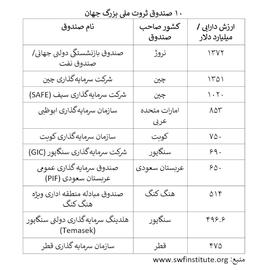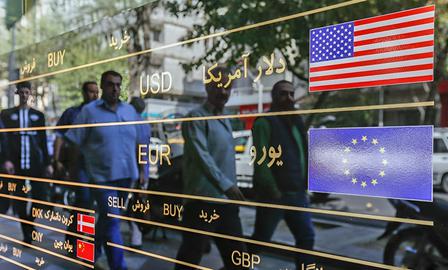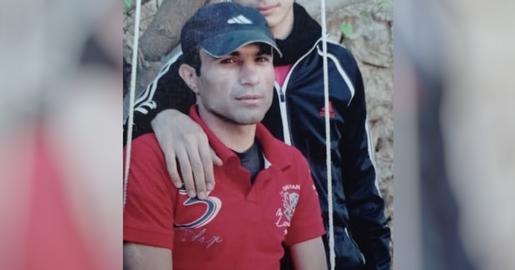“If the depreciation of resources continue, the National Development Fund will be completely annihilated,” Mehdi Ghazanfari, chairman of the fund's board of directors, has warned.
The sovereign wealth fund was established in 2011 to transform revenues from the sale of oil, gas, gas condensate and oil products into productive investments for future generations.
The fund is a member of the International Forum of Sovereign Wealth Funds and therefore has signed up to the Santiago Principles on best practice in the management of such funds. Withdrawing any money from this fund requires Supreme Leader Ali's permission.
***
A $10 Billion Leftover
According to Mehdi Ghazanfari, as of now $150 billion has been collected by the National Development Fund from Iran’s oil export revenues, but only $10 billion of this amount remains after $100 billion were withdrawn by various administrations and $40 billion were given as loans to private sector for investments.
These numbers show that 67 percent of the fund’s resources have been withdrawn by the government under different administrations. In September 2022, Ghazanfari said the fund had received around $145 billion, half of which had been withdrawn over the previous 10 years.
Aside from differences in the numbers cited by Ghazanfari, he also left some things unsaid because he is either unwilling or afraid to talk about them.
The National Development Fund was founded after the failed experience of the Currency Reserve Fund, which was controlled by the government. But it seems that, after operating for more than a decade, the National Development Fund is faring no better than the Currency Reserve Fund.
The Currency Reserve Fund was approved by parliament in 2000, but the government considered it as a piggy bank and withdrew money from it whenever it found itself in a financially tight spot.
As a result, the National Development Fund was set up in part to limit and control the government’s access to the funds.
Who Is Behind the Abuse?
If we assume that Ghazanfari has done his bookkeeping correctly, then the $100 billion, or 79 percent of the fund’s reserves, withdrawn by the government are gone for good. Last winter, citing the same number in a tweet to members of the parliament, Ghazanfari wrote: “Recent administrations have withdrawn around $100 billion from the National Development Fund. Would the respectable members of parliament specify in the 7th Development Plan and the annual budget how this debt will be repaid?”
Ghazanfari is still hopeful that perhaps one day the government will repay this debt. “Giving a loan to an administration is not the same as giving it [financial] assistance, meaning that these loans must be repaid,” he said on May 14.
What Ghazanfari has not mentioned is the mechanism that has allowed these withdrawals by the successive administrations. Khamenei has issued withdrawal permits to finance the military budget, increase the salaries of government employees, manage maritime borders and pay the government’s expenses, among other things. He also permitted the fund’s share of the proceeds from the export of petroleum products to be reduced.
That did not stop Zabihollah Khodayan, the chairman of the National General Inspection Organization, from saying, “Without the Supreme Leader, today the National Development Fund would not have even one dollar.”
Loans Rather than Investments
The National Development Fund has also provided loans to private sector projects. One would expect that these currency loans and the interests attached to them have a better chance of being repaid than the government’s debt.
However, from statements made by the fund’s official, we learn that a number of borrowers have asked to repay their loans in Iranian currency at the exchange rate that was in effect on the date the loans in dollars were granted. Considering the ongoing plunge in the value of the Iranian currency, this means that the borrowers want to settle their accounts by paying only a portion of what they owe in dollars.
Requests to delay the repayment installments is another problem the fund faces. In July 2022, it said it had agreed to delay the repayment of 184 loans more than 360 times.
The National Development Fund reports that, from 2011 to 2021, it granted 52 percent of its loans to “non-governmental public organizations” and the rest to the “private and cooperative” sectors. But the amount of loans given to non-governmental public organizations were seven times higher than those granted to the private and cooperative sectors, which shows that the loans granted non-governmental public organizations were used to finance large projects.
Ghazanfari complains that most activities of the fund have been limited to giving loans in foreign currency instead of investments. However, in October 2022, he said the opposite.
Dreaming of Investments Under Sanctions
This contradiction aside, the main question is this: Why the activities of the National Development Fund have been mostly limited to giving out loans and why it has not engaged in investments like its rich counterparts in other countries have done?
Part of the answer probably lies in the limited expertise of the fund in evaluating investment projects, estimating the return on investment and calculating the risk.
But the answer has a more important part that, perhaps, could be better illustrated by asking more questions. For example, how investments beyond the borders of Iran can work if we consider that the country is under heavy economic sanctions, is blacklisted by the Financial Action Task Force (FATF) and has been barred from the SWIFT financial messaging service? Even if the impossible happens and the fund finds an opportunity to invest in the international financial market, how can it guarantee that this money will not be frozen? And, beyond anything else, what country or which project owner is willing to accept the risk of accepting an investment by the National Development Fund?
We can write a long list of questions to explain why the National Development Fund has not acted in accordance with its charter and has not invested in international financial markets or projects in other countries.
“The fund must grow every year because if it doesn't it would mean that we haven't bequeathed anything to the next generation, and those who don't bequeath anything to the next generation cannot claim that they are wise,” said Ghazanfari.

visit the accountability section
In this section of Iran Wire, you can contact the officials and launch your campaign for various problems























comments